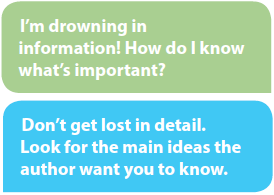Once we have read over an article to establish a good understanding of the main topic and ideas, we can begin to filter the information.
Note
This lesson is based on the article by Marcus Wohlsen:
Wohlsen, M. (2016). Digital literacy is the key to the future, but we still don’t know what it means. WIRED. Retrieved 14 April 2016, from http://www.wired.com/2014/09/digital-literacy-key-future-still-don’t-know-means/
If you haven’t already, you will want to read the article now.
You do not need to have completed Lesson A to enjoy this lesson. If you haven’t completed it, you can use the following resource to help you in this lesson:
We filter all the information in an article in order to highlight the essential points and illustrate the logic within the author’s argument.
This lesson includes two steps:
- Distinguish the essential information from supporting detail.
- Create a reverse outline of the article, which means to recreate the outline of ideas the author used to write the article.
Distinguish Key Points from Supporting Details

Perhaps the biggest challenge in producing a summary of an article is forcing yourself to distinguish between key points and supporting detail. Often the examples and anecdotes that make up the supporting detail are the easiest parts of an article to understand and engage.
However, it’s essential not to be drawn into the detail. Your task is to find the most important things the author wants you to know. One way to do this is to create a reverse outline.
Create a Reverse Outline
To create a reverse outline, you work backwards from the article to produce what the author might have used as an outline.
Now, we will work to refine and filter information to avoid too much detail. Based on a reverse outline, we should be able to see exactly what the author wanted to say, and get a clear sense of how they said it.
Reverse Outline Template (Reference)
Topic and Main Ideas:
- Capture the core purpose of the article.
- Why did the author write this article? What did they want us to know?
|
| Topic: |
State the topic or question the author is interested in. |
| Main Idea: |
State the main message or argument. What does the author say about the topic? |
Key Points:
- Filter the article content until you find the 2 or 3 key points that are developed in the discussion. Each of these key ideas might develop over several paragraphs, but could be summarized in a sentence or two.
You do not need to summarize every detail. You do not need to summarize the information in every paragraph.
- For each of these key points, note the content and the function.
The content is the actual point that the author expresses.
The function is the role that point plays in the article. Is the point an example to help develop the argument? Is the point key background information that we need to understand the argument? To identify the function, ask yourself why the author has included this information in the article.
|
| Key Point #1
Content:
Function: |
| Key Point #2
Content:
Function: |
| Key Point #3
Content:
Function: |
Practice Completing the Reverse Outline
Let’s use this template now to practice completing a reverse outline of the Wohlsen article.
Wohlsen, M. (2016). Digital literacy is the key to the future, but we still don’t know what it means. WIRED. Retrieved 14 April 2016, from http://www.wired.com/2014/09/digital-literacy-key-future-still-don’t-know-means/
Type your answers into the boxes provided, and click to see sample answers.


Reverse Outline of Wohlsen’s Article (Sample Answers)
Topic:
- The author is interested in the problem of how to define digital literacy.
- Basically, Digital literacy is “the idea that the world’s citizens, and kids in particular, will benefit if they’re skilled in the ways of information technology”.
- But the problem is how to define exactly what technology skills kids actually need in the future. “Learning to code” is important, but it’s not always clear what that really means.
Main Idea:
- Wohlsen, using ideas from many experts in the technology and education fields, argues that skills in “computational thinking” or an “algorithmic mindset” are key to digital literacy.
- Such thinking, informed by the logic of coding, will be crucial in a world driven by information technology, and not just for those involved directly in computer programming.
Key Point #1
Content:
Defining digital literacy is important to ensure the younger generation develops the skills they need in the future.
Function:
Justifies the importance of the topic and his article.
Key Point #2
Content
Skills in “computational thinking,” including the ability to understand algorithm, can be applied outside the context of basic computer programming to solve larger social problems, especially in a world driven by data and information technology.
Function
First reason why these are the skills key to digital literacy, and necessary for the next generation.
Key Point #3
Content:
With the critical thinking skills informed by the logic of “computational thinking” the next generation will be able to make technology do what they want it to do.
Function:
Second reason why these are the skills key to digital literacy, and necessary for the next generation.
Key Point #4
Content:
Skills in “computational thinking” are critical thinking skills that show deep knowledge of the logic of coding. These must be distinguished from simply knowing how to use technology; we need to be creators rather than consumers.
If we mistake the ability to use computers with the ability to think within the logic of coding, we risk missing the opportunity to provide true digital literacy.
Function:
Comparison to other approaches to digital literacy.
Key Point #5
Content
The limited skills base among teachers is one barrier to achieving this digital literacy.
Function
Identifies limits to his argument about the skills needed for digital literacy.
Download Sample Answers


